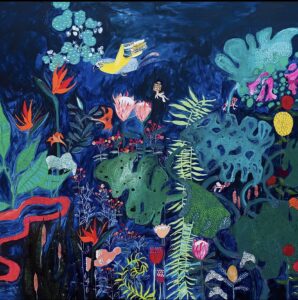What is Nothing?
A Strange Note in Shinde*
Gravity, science says, is a force responsible for our ability to make bodily contact with the earth. As we experience this essential energy that transcends our understanding of its nature, one easily forgets – distracted by the daily ins and outs of life – about the space that holds the stars and our inevitably temporal planet, where gravity takes on a new face; decreasing by distance and, in the absence of an additional force, causing masses to float in nothingness. When we imagine this nothingness, we picture emptiness; a form of blackness floating over an endless void, which would imply the presence of nothing. But if we imagine blackness as a component of nothingness, haven’t we, then, made nothing something?
We often see nothingness as the absence of, and this contradicts our association of nothingness with colours. It also contradicts our identity as sentient creatures with years of exposure to elements within our planet, an attribute that greatly influences our perception of reality and inspires our use of language in naming things and experiences.
One such experience through which the concept of nothingness remains unclear is near-death experiences. We’ve all heard the stories; humans with near-death experiences either attesting to the existence of the after-life or dismantling our understanding of reality through accounts of out-of-body experiences. With near-death experiences, nothingness is brought to the bar in two ways; one being through the self’s encounter with nothingness- in form of bright lights or absolute darkness, and the other in our questioning of their experience and conclusion of it as falsified and, subsequently, nothing.
This dismissal of near-death experiences as nothing is primarily enabled by science, our avenue for demystifying and easing our experience of reality. Through the lens of science, for example, Christopher Timmermann and his team of researchers, in 2018, explored Near-Death Experience and its similarities with the psychedelic substance, N, N-Dimethyltryptamine or DMT.
The potency of fantasia, as DMT is commonly called, surpasses that of the common Lysergic acid diethylamide (LSD) and magic mushrooms, as its intense effect kicks in early, triggering a temporary altered state of consciousness.
‘Near-death experiences (NDEs)…’ the researchers write, ‘are complex subjective experiences, which have been previously associated with the psychedelic experience and more specifically with the experience induced by the potent serotonergic, DMT. Potential similarities between both subjective states have been noted previously, including the subjective feeling of transcending one’s body and entering an alternative realm, perceiving and communicating with sentient ‘entities’ and themes related to death and dying. Result: we found significant relationships between the NDE scores and DMT-induced ego-dissolution and mystical-type experiences.’
Timmermann and his team note that the pharmacology of near-death experiences is that endogenous DMT (that is, DMT present in our body) is released in significant concentrations during the dying process. Simply put, DMT, this powerful hallucinogenic substance occurring naturally in many plant species and synthesized in laboratories, is speculatively released from the pineal gland during birth and death.
This theory leaves us with a question that enables the dismissal of near-death experiences as nothing; if the mind is being influenced by this substance, is it possible that one’s near-death experience is merely an encounter with nothing but imaginations formed by a constellation of long-term memories and contact with reality? In contemplating nothingness as a component of near-death experiences, we are made to ask a second question; for those who declare to have seen nothing but a bright light or utter darkness, isn’t that too something?
The mystery of nothingness is also exposed in common activities like our use of speech to hide pain, and moments of nocturnal dreaming. When we say ‘it’s nothing’ to questions about our stressors, we hide nothing in something, giving it an unspoken, yet understood identity. When, at night, we ferry into the unknown corners of sleep, where do we go? Into nothingness? Or is the mere act of being asleep just something for nothing to exist, thus giving meaning to nothing?

Nothing is the foundation of all things. When we hear and echo aphorisms like ‘I know nothing’, we believe it to be a saying that grooms our intellectual capacity, driving us to strip all confidence in our knowledge and objectively learn from the world. But what does it mean to know nothing? Isn’t it just a desire to know something? Everything, one might argue. In collecting knowledge through a similar lens of curiosity applied by children, we do so, not with nothing, but, indeed, with something. An intention.
Nothing is a component of our emotions and response to events. When we fear, we live in nothing; the dark empty space where our minds are dragged by unseen weights. When we fail, we are gripped by nothing; the emptiness of regret and contemplation from fear which is in itself nothing. When we laugh and cry, we fill the nonexistence of those emotions with something that births them. When we say we are hopeful and choose to work with faith, we fill the absence of (which indeed is nothing) with a picture of our desire for.
Nothing is you. You who would not own your current identity, had you, say, a different set of parents or were you, say, born within a different environment or time in history. We are only something because of things, and things are elements that fill nothing. In this way, existence is nothing and we are the things that make it something. The past is nothing and the future is something that will become nothing to us when we cease to be something.

A visit to the Mine Moon by Simphiwe Ndzube. 2019.
1 Question for You
How do you define reality?
As you think through this question, here’s what you should read next: consume the research work on NDEs by Timmermann and his team, dig through the four fundamental laws of Nature, and uncover the multiplicity of identity.
*Shinde is the Bemba word for the month of April. Bemba is a Niger-Congo language spoken in Zambia and the Southern Democratic Republic of Congo by over 3 million people.
 @etashelinto
@etashelinto